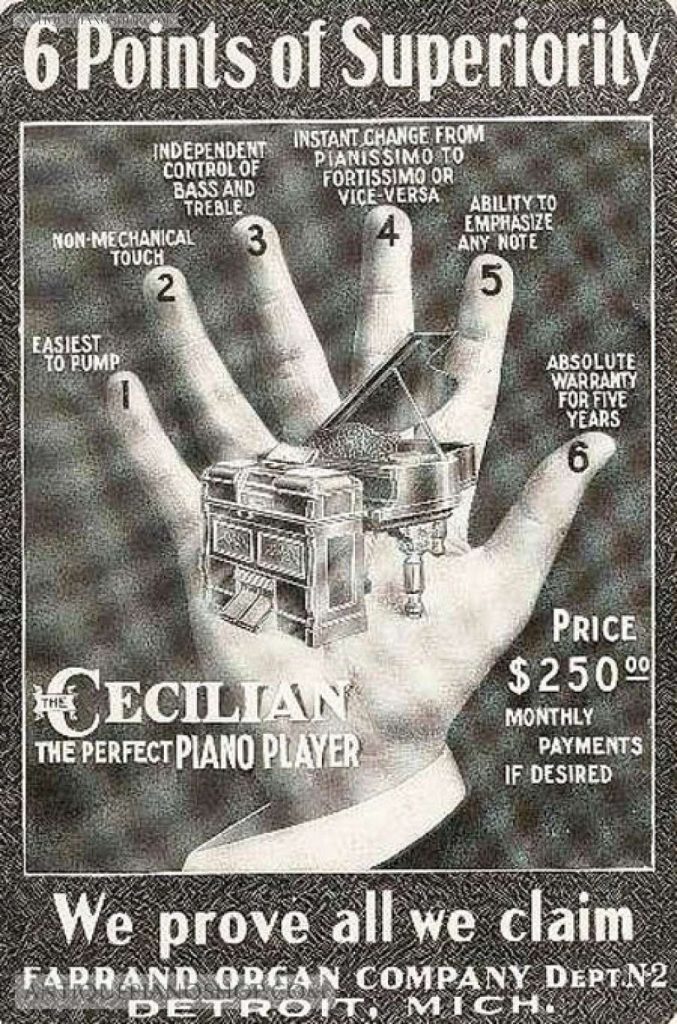Vorsetzer Player Piano
Details
- Origin: Detroit, Michigan, U.S.A.
- Date: Post-1904
- Maker: Farrand Piano Company
- Collection: E 417
Description
Has a mahogany veneered case, two now-unusable foot pedals originally made to operate the bellows, designed to be placed in front of a piano, adjustable for height, and its “fingers” are controlled by bellows and a valve mechanism that turn a paper roll inside that would play the piano. Has “Cecilian” painted on the nameboard, “Cecilian / TEMPO INDICATOR / FARRAND ORGAN CO. DETROIT, MICH. U.S.A.” on a plaque inside the control case at the front, “FARRAND / ORGAN COMPANY / DETROIT, U.S.A.” on the decal in the back below the keys, “CECILIAN / 8258 (in red) / PATENTED / [list of 15 patent dates, 1901-1904] / INSPECTED BY Willard Hathaway (signature)” on a paper slip inside of the piano mechanism.
The first full player piano was invented in 1901 by Melville Clark, another addition to the long line of self-playing instruments. The original idea, however, came much earlier from American engineer E.S. Votey, who patented the similar “pianola” in 1897. Piano players are designed to be set in front of actual pianos, with a row of wooden “fingers” set over the piano keys that would be able to play the notes according to the inner mechanism. Inside of piano players are paper rolls with holes punched through them, denoting desired keys to be struck. When the roll is activated, it spins past a tracker bar that registers the holes in the paper, and a foot-pressed bellows and valve device releases air that corresponds to individual fingers that, thus, play the piano. There are other attachments that correspond to accents, tempo, and more. The foot-pumping device ultimately became incorporated into actual pianos later on as a means of altering the sound, especially as the short age of player pianos came to a close in the 1930s thanks to the rise of radios and phonographs.
This particular player piano was made by the Farrand Piano Company, which first began operation as the Detroit Organ Co. in 1881. Founded in Detroit, Michigan, it was purchased by C. J. Whitney and E. S. Votey in 1887 and changed to Farrand & Votey, and then in 1897, with Votey leaving the company to specialize in reed organs, it was renamed “Farrand Piano Company” as Farrand focused production on pianos and player pianos. The company built successful “Cadillac Piano” player pianos during the early 20th century, and the company came to be known for its quality and sterling reputation. Later on in the century, its player pianos were built under the brand names “Farrand” and its signature “Cecilian.” Farrand Organ Co. went bankrupt in 1915.

Sources
“Farrand & Votey Organ Company.” Pump Organ Restorations. Accessed June 17, 2022. https://www.pumporganrestorations.com/farrand_&_votey_organ_company.htm.
“Farrand (Farrand – Cecilian Company).” Antique Piano Shop, February 22, 2022. https://antiquepianoshop.com/online-museum/farrand-farrand-cecilian-company/.
Lienhard, John H. “No. 692: Player Piano.” Engines of Our Ingenuity. Accessed June 17, 2022. https://www.uh.edu/engines/epi692.htm#:~:text=In%201901%2C%20Melville%20Clark%20invented,silence%20when%20you%20craved%20music.
“Player Piano.” Encyclopædia Britannica. Encyclopædia Britannica, inc., September 9, 2019. https://www.britannica.com/art/player-piano.




